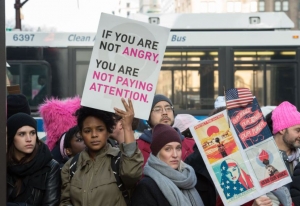
Hundreds of thousands of people flooded US cities Saturday in a day of women’s rights protests to mark President Donald Trump’s first full day in office. / AFP / Bryan R. Smith (Photo credit should read BRYAN R. SMITH/AFP/Getty Images)
Sarah Hochberg, Opinion Editor
February 15th, 2017
On January 21st, a day after the Inauguration, I joined the ranks of women from all over the country to march. It was an amazing moment to be a part of, to experience so many people showing up and coming out for a unified cause. While the specific goals of the march were wide and varied, I did have my own set of ideas for why I was marching. My personal agenda was to stand for the rights of all female-identifying people to receive health care in a safe, non-judgmental platform. I believe strongly that women should have rights over their own bodies, and should be able to act as individuals, without government interference that men don’t experience.
Immediately upon exiting the 6 train at 51st street to make my way with a few friends to the march route, I began noticing some traits of the march that surprised me. A lot of signs and slogans were trans-exclusionary, focusing within the gender binary instead of including the range of possible gender identities. Looking around, I saw pockets of women of color but the large majority of marchers were middle class white women, which surprised me in the streets of New York. The general atmosphere seemed odd as well; it had a righteous-yet-festival type of vibe, like an animal rights benefit concert. There were group photo shots and friends gathered, but the march lacked a sense of urgency, a sense of the full weight Trump’s administration and his policies will have groups of underrepresented minorities.
This is not to call out what was one of the largest gatherings of people in my time, nor discredit all the good I believe the Woman’s March did, but rather the complete opposite. This is to call myself out. As I marched with my friends, I noticed I belonged a little too well. I was surrounded by other white, middle-to-upper-class college students. There wasn’t a fear of authority, or a real sense of resistance. We were a collection of, largely, young adults who joined because we share a hatred of Trump but only a vague notion of how to turn that into a constructive resistance of the administration’s policies. The Woman’s March, which was a wonderful, beautiful and empowering experience shared by women across the country, did not include as many women of color as it could have, making it a movement I had mixed feelings about joining.
In a political climate where every major decision feels like a backwards step for the country I love so much, acts like calling my representatives, sending postcards (courtesy of Roosevelt Institute at Goucher) and volunteering at local organizations whenever possible feel like I’m making a tangible effort to oppose the government in the only ways I know how. But within the paradox of white activism, I’m unsure of my place in a march or protest. I want my feminism to be intersectional, and my activism to be inclusive, but I’m unsure how to use my white privilege in a way that doesn’t take away someone’s voice. As a white privileged college student, I want to participate without dominating a space.
